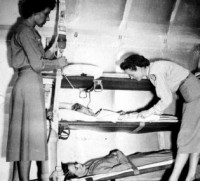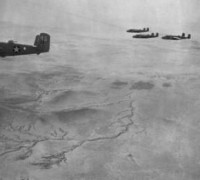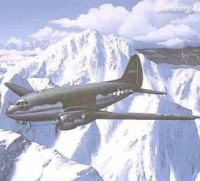WAR IS OVER - THE HOMEWARD BOUND TRAFFIC - AIR EVACUATION
3)THE GREEN PROJECT
Though the CBI theaters, Persian Gulf Command, and Africa-Middle East theaters together supplied over 10,000 GREEN PROJECT passengers, the overwhelming numbers came from the European and Mediterranean theaters. Indeed, from May through September ETO provided a clear majority both of the Green Manifest travelers and of the normal traffic. But Orly Field near Paris, and Prestwick, the major European ports of aerial embarkation for westward flight by ATC craft, handled only a lesser fraction of the Green Manifest passengers.
Casablanca, take-off point for virtually all South Atlantic, and most Middle Atlantic flights, was the hub of the system. Converted B-17's belonging to the Eighth and Fifteenth Air Forces, and operating entirely outside the ATC organization, brought the men from staging areas at Istres Airport, Marseille, and at Pomigliano and Pisa airports in Italy, to the Port Lyautey Naval Air Station or to the Cazes Air Base, Casablanca.
At these points the men came under ATC control and boarded a C-54 for the first stage of their transatlantic flight, either to the Azores or to Natal by way of Dakar. In August the use of Port Lyautey was abandoned, and all the traffic was concentrated at Cazes. At the peak of the movement, 8 August, that base dispatched 1,775 GREEN PROJECT men southward or westward in a single day. GREEN PROJECT C-54's normally made the flight from Casablanca to Dakar in seven and a half hours. With a scheduled stop of an hour at Dakar, the big transports, backed by the trade winds, pushed on to Natal, eight hours and fifty minutes away.
Two of the ranking commissioned or non-commissioned officers assigned to ride on each C-54 had usually been trained as plane group leaders, to maintain cabin discipline and cleanliness, and to take charge of the passengers if it should be necessary to ditch the ship. At Parnamirim Field, Natal, the travel-weary passengers came into the jurisdiction of the ATC‘s South Atlantic Division.
There, usually after an interval for rest and refreshment, they might be transferred to one of the C-54’s operated by Caribbean Division crews on the Natal-Miami run, or one of the twenty C-46’s flown largely by Eastern Air Lines personnel for that division. More commonly, however, their planeload of forty was divided into two equal groups, each headed by a plane group leader, and loaded on a pair of C-47’s, flown by military pilots, late of a troop-carrier group and now flying for the ATC. The crews, including a navigator only if the flight was at night, took the transports from Natal to Belém, nearly six hours northwest.
After a change of crews, the plane went on to Atkinson Field, British Guiana, five and a half hours farther on. The C-47 fleet was so scheduled that regular 25-hour inspections fell due at Atkinson Field for planes northbound. Long before the four-hour task was accomplished, however, the passengers took off on another plane which had arrived earlier and whose inspection had been completed. At Atkinson, too, a fresh crew, from the Caribbean Division, took over. A last stop at Borinquen Field, Puerto Rico, six hours and forty minutes out of Atkinson, was a virtual repetition of that at Belém.
Still another crew took over for the final six-hour run to Miami. On an average, the returning soldiers had been en route seventy-two hours from Casablanca. Those who took the more direct route, via the Azores, commonly reached Miami, La Guardia Field (New York), Washington, Presque Isle, or Wilmington, within thirty-six hours after their departure from Casablanca. There were numerous chances for delay along the way, quite apart from a long wait at or near the port of embarkation.
One unavoidable cause, even in summer on the relatively favorable South and Middle Atlantic routes, was weather. In August tropical hurricanes in the Caribbean twice virtually stopped all homeward-bound traffic on the Natal-Miami route. If for any reason, such as a breakdown in maintenance, enough serviceable transports failed to reach such critical points as Casablanca, Lagens, Natal, or Atkinson Field, a backlog would pile up.
To take care of such situations as well as weather delays, ATC used what was known as "Station Block Control." That is, each base, as its backlog approached capacity, was entitled to call a halt to flights from the next point east and to ask help from division headquarters in the form of extra sections on established schedules. This system worked tolerably well, yet the rate of flow was never completely steady. On the other hand, passenger backlogs never became completely unmanageable.
From the start, it was clear that ATC could not furnish this mass movement of troops all the refinements of passenger service which had lately become common on the best of its regular transport runs. Still the intent was to make the homeward journey of the GREEN PROJECT men as pleasant as possible.
Serious effort was directed toward this end; the service improved as the servers gained experience and as their superiors increasingly stressed the importance of consideration and hospitality in dealing with the passengers. At Natal hot meals were served around the clock to the returning soldiers, who also had an opportunity to exchange dirty clothing for clean. Elsewhere steps were taken to improve the quality of transient messes. Careful planning, based on experience, cut to a minimum the time lost in assigning arriving planeloads to their billets.
A spot check at Natal on 6 July showed that only thirty-five minutes elapsed between the time a load of passengers from the east deplaned and their arrival at their individual bunks in the transient area. Medical dispensaries were set up on the flight lines, so that passengers' minor ailments could be quickly treated and their fitness for further flight determined, but passengers seemed to shun this service lest perchance it might delay their homeward passage.
Post exchanges were stocked with a liberal array of souvenirs and other articles which the transients would be likely to purchase, such as Natal boots or silk stockings and perfume for the folks at home. At Natal a package-wrapping room was set up, and free movies were available. Reading matter was provided on board planes and on the ground.
The South Atlantic Division, and later the Caribbean Division, supplied their customers with booklets telling them something of the division's organization and of the land and water over which they were to fly after some early passengers had suggested it, planes were supplied with blankets to soften bucket seats or to keep the passengers warm at high altitudes. When the backlog at Natal fell so low for a time that men had no opportunity to stop there for a good rest, the South Atlantic Division tried installing eight or nine litters on northbound C-47's, so that passengers might take turns sleeping in modest comfort.
The Caribbean Division objected, however, on the ground that the weight of the litters, even though not enough to top the permissible gross weight limits, lessened the margin of safety. This last was a prime consideration. Elaborate precautions were taken. A string of seaborne vessels, British, American, and Brazilian, stood watch on the surface of the Atlantic under the airways. B-17's equipped to drop boats and amphibious aircraft took station at critical points along the routes.
Before emplaning, passengers saw films instructing them in safety precautions and ditching procedures. Care paid off, for the whole project was completed without the loss of a life. The worst accident of the entire movement occurred on 24 June, when a C-47 on instruments between Belém and Atkinson Field, flew into two thunderstorms, and in the turbulence fifteen passengers were injured, four enough to require treatment at the Atkinson Field station hospital.
At the ports of debarkation Green Manifest passengers bypassed the usual customs and quarantine procedures and were quickly taken to billets to await the arrival of surface transportation which took them out of the control of the ATC and delivered them to the Army Service Forces. Thereafter they were sent either to a separation center or to their homes for thirty days of temporary duty prior to receiving a new assignment.
At the end of their air journey, passengers were given an opportunity to record their impressions or criticisms. It must be remembered that many of ATC's ranking officers were on leave from civilian airlines and that they were interested in converting potential American passengers to air travel. Comments on the GREEN PROJECT were predominantly favorable.
There were complaints and suggestions, of course. Some men thought that they should have been issued summer uniforms for travel through the tropics, others naturally complained of delays experienced, particularly at European staging centers, where some men claimed to have been held as long as six weeks. Many would have appreciated maps of the countries over which they had flown and more information about those regions. But the large majority responded gratefully to the efforts which had been made for their comfort, to the apparent advantages of air travel, and to the efficiency and dispatch with which they had been handled at the Air Transport Command bases en route.
One infantryman wrote: "I have enjoyed my trip . . . and would like to see everyone in the ETO get the chance to fly home. . . ." Another was impressed by the consideration shown the passengers: "The air crews are very courteous regardless of rank, and being a private myself, I know." Like much of the other planning in the spring of 1945, the GREEN PROJECT was predicated on the belief that the war against Japan might not be concluded before the following spring.
But early in August, as the Japanese surrender became imminent, new commitments to the Pacific forced ATC to transfer to its Pacific routes eighty-two C-54's, most of which were then in use on the GREEN PROJECT. As a result, by 10 August GREEN PROJECT goals had been cut from 50,000 to 35,000 a month. By 22 August some seventy of the C-54's so hastily withdrawn from the Atlantic routes and ten more from new production had reached the West Coast.
With the end of all hostilities, ATC once more restudied the GREEN PROJECT. On 23 August General George recommended that the westbound passenger lift across the Atlantic be reduced to10,000 persons a month. Since surface shipping capable of moving about 350,000 monthly was operating between the United States and Europe, continuation of the airlift at the current rate for another seven months could speed the end of demobilization from Europe by only Fifteen days.
Cutting back the project to 10,000 persons a month would enable the ATC to release approximately 150 of the GREEN PROJECT C-47's operating on the Natal-Miami line, about half of the 227 C-54's still in service on the project, and some 30,000 officers and enlisted men then assigned to bases in the Caribbean, South Atlantic, and North African Divisions. Likewise, the four bombardment groups still delivering passengers to the ATC at Casablanca might be relieved.
Within four days, General Marshall approved this recommendation, and orders presently went out to terminate the GREEN PROJECT on 10 September and to cut the transatlantic lift to 10,000 westbound passengers monthly. The special procedures for handling passengers continued in use until the end of September. By that time the remnants of the project fleet had brought home from North African, South Atlantic, and Caribbean bases a major portion of the men whose labors had made possible the air journey homeward of over 166,000 of their fellow soldiers.
When the GREEN PROJECT goals were reduced in mid-August, fifty C-47's, formerly based at Waller Field and used on the Natal-Miami circuit, together with their crews and some maintenance personnel, were transferred to Morrison Field, West Palm Beach, Florida. After the crews had received instruction for flying within the Zone of Interior, they were put to work, 20 August, flying PURPLE PROJECT support personnel from Miami to the Charleston Army Air Field, South Carolina. By 4 September 1,671 men had been moved.
Before this, part of the fleet had been withdrawn to provide the air transportation from Miami to San Antonio, Texas, of Brig. Gen. Ray L. Owens' AAF Redistribution Center. Between 30 August and 7 September, 2,029 of Owens' men moved out in a total of 112 C-47 flights. Meanwhile, on 27 August, at the request of the War Department, ATC inaugurated still another project which reflected the end-of-the-war wealth of aircraft available.
This was the TRANSCON PROJECT, designed to carry first 25,000, then 40,000, troops monthly between the East and West coasts, in order to relieve some of the extremely heavy pressure on rail transportation produced by the monthly return of hundreds of thousands of troops from overseas. Soldiers transported under this new project were to carry ASF orders designating them as TRANSCON passengers. Ferrying Division supervised the whole movement, and its Military Air Transport Service C-47's ultimately carried a major share of the passengers.
Four contract carriers, American Airlines, Northwest Airlines, United Air Lines, and Transcontinental and Western Air, Inc., also shared in the movement. Each of the contract carriers employed in the project fifteen new C-47B's, specially delivered, and pilots released for this purpose from military service. In December American Airlines received twenty-two C-54's to be used for TRANSCON. When the job was finished, 1 April 1946, 171,579 troops had been afforded coast-to-coast transportation.
With victory in the Pacific achieved, and the heart of the Japanese empire under American occupation, a final homeward movement, the SUNSET PROJECT, developed. Inaugurated 27 September 1945, it called for the return to the United States of B-29's from the Eighth and Twentieth Air Forces, and B-24's from the Far East Air Force, as well as some two-engine bombers and cargo craft not required by the occupational forces.
Like the WHITE PROJECT planes, those of the SUNSET PROJECT were accepted by ATC for overseas flight, after inspection at Manila, Okinawa, and various B-29 bases in the Marianas. They were flown by combat crews operating under ATC control and carried passengers assigned as extra crew members, all being eligible for separation from service.
The returning aircraft passed through the Marianas, Kwajalein, Johnston Island, and John Rodgers Field (Oahu) to Mather Field, California. The flow continued through the rest of the year and on into 1946. By New Year's Day, 653 B-29's and 601 B-24's had made the homeward journey, though the discharge of hundreds of experienced aircraft mechanics left the Pacific Division hard pressed to perform the necessary maintenance en route. In all, 1,308 very heavy and heavy bombers returned to the United States under the original SUNSET PROJECT designation.
Of all the aerial redeployment programs of 1945, the GREEN PROJECT was the most impressive. It illustrates the capacity of the War Department, and particularly of the mature Air Transport Command, to plan an air transportation operation of tremendous magnitude and to carry it out in a completely effective fashion. At a Word from Washington supplies of every kind were procured and transported to the points where they would be needed.
Several thousand men were moved by air and water and were put to work again, often, at entirely unfamiliar assignments, thousands of miles from their previous duty stations. It is no wonder that the mimeographed Standard Operating Procedures prepared for the project in several of the participating divisions ran to over seventy-five pages.
It was a tremendous demonstration of the mass airlift of manpower, certainly the most striking of those marking the end of the war. Within less than five months, over 166,000 passengers—50,514 in a single month—were flown across the Atlantic without a single fatality. Nothing like it had happened before. What its sequel might be—for peace or war in a day of larger, more efficient air transports, was a challenge which demanded little of the imagination of the men who had had a part in it.
Transcribed and formatted by David Newton for the Hyper War Foundation


